Depending on the nature of the stored goods and the frequency of use, different storage techniques are suitable. Different techniques can also be used in one building.

Storage techniques can be divided into the following types, all of which are listed on this page:
- Floor storage
- Static rack storage
- Dynamic rack storage
- Storage on conveyors
- Special case channel rack warehouse
Storage techniques – floor storage
In floor storage, the goods are stored without fixed devices, such as shelves, mounted in the warehouse.
Floor storage is to be divided into three basic types:
Unstacked warehouse
In the case of unstacked storage, the loading units are stored next to each other. An unstacked warehouse consumes a lot of space and is, therefore, less suitable for use inside closed buildings. It is mostly found in open warehouses with a small number of different articles.
Block storage
In block storage, the loading units are stored without fixed devices, such as shelves. The goods are usually stacked in several layers on top of each other and next to each other. The goods, for example in boxes or on pallets, are usually stacked in several layers on top of each other and next to each other. The use of a block warehouse is suitable for goods of the same type, rarely required goods and high withdrawal quantities.
In the case of stable, non-pressure-sensitive goods, simple pallets without their own devices are sufficient for block storage. In the case of unstable goods, box pallets or crates are suitable.
Advantages and disadvantages of block storage
The advantage of block storage is cost savings, as the packaging materials are stacked on top of each other, and no shelves are required. The absence of shelving also eliminates maintenance and investment costs. Since the block warehouse does not contain any shelves that provide a fixed structure in the arrangement of the packaging materials, the arrangement of the goods can be changed at any time.
Disadvantages of block storage are poor access to individual articles. In addition, high access times can occur when goods are to be removed that are difficult to reach due to other goods stacked in front of them. If sufficient space is available, the goods can be removed or added to the block storage from all sides. However, if access to the bearing is restricted, the disadvantage arises that only the LIFO principle (last in, first out) is possible without problems.
Row storage
With row storage, storage is basically the same as with block storage, but there is free space between individual blocks. This means that the goods can be accessed without having to transfer units.
In the floor row warehouse, the loading units are stored in rows, with the corresponding free spaces between the individual blocks. In contrast to block storage, this makes it easier to access individual loading units.
Advantages and disadvantages of line storage
The advantage of row storage – analogous to block storage – is cost savings, as no shelves are required. This means that the arrangement of the goods can be changed at any time, as there are no structuring elements.
The disadvantage of row storage, as with block storage, is that only the LIFO principle (last in, first out) is possible without problems. The row storage system also requires more space than the block storage system.
Storage techniques – Static rack storage
In contrast to block and row storage, static rack storage uses fixed racks. Loading units are stored single-deep or multiple-deep on it and only moved again during the retrieval process.
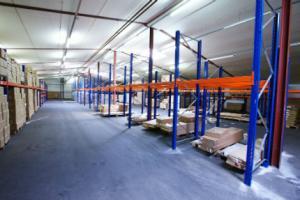
Static rack storage is to be divided into seven basic types:
- Shelf storage with single-deep occupancy
- Drive-in and drive-through shelving warehouse
- satellite rack storage
- shelving storage
- drawer rack storage
- cantilever rack storage
- honeycomb racking warehouse
Shelf storage with single-deep occupancy
One design of the single-deep rack storage system is the standard pallet rack storage system. The storage racks of the warehouse consist of fixed field widths between the supports. The bays offer space for one or more pallets, whereby the storage of the loading units takes place single-deep.
The standard field widths of 2.70 m or 3.60 m are matched to the dimensions of the Europool pallet(800 mm × 1200 mm) or the German industrial pallet (1000 mm × 1200 mm). The composition of the shelf structure is usually steel or aluminium profiles. Single-rack warehouses can reach a height of up to forty metres (high-bay warehouse); each loading unit can be accessed directly.

Advantages and disadvantages of rack storage with single-deep occupancy
The advantage of the single-deep occupancy is that this storage type is well suited for automation due to the direct access and the geometrically well-defined position of the loading unit in the shelf.
The disadvantage is the comparatively low degree of volume utilisation, as there must still be enough space between the shelving levels and compartments to ensure effortless storage and retrieval.
The container rack warehouse as a variant for more sensitive goods
A further design of the single-deep rack storage system is the container rack storage system. As a rule, the packed product copes better with the horizontally acting acceleration force than palletised products, since it is enclosed by crates, lattice boxes or the like. Container racking warehouses are often used for automated small parts warehouses.
Drive-in and drive-through shelving warehouse
The drive-in or drive-through shelving system is a support construction made of profile elements. For storage and retrieval, the floor conveyor can retract or pass through. While the LIFO (last in, first out) principle is used for retrieval from drive-in racking, the sequence of retrieval from drive-through racking can vary. The storage sequence is the same for both rack storage systems.
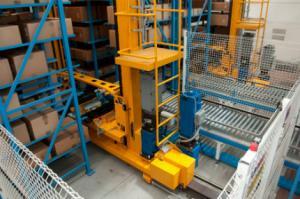
Continuous cross beams connect the vertical supports and are used to place loading units on them. The cross beams are filled from the rear to the front of the drive-in and drive-through racking. The load must be lifted to the level of the shelving level before retraction. While stock placement begins at the top level and ends at the bottom level, stock removal takes place in reverse order. This means that the first loading unit is filled in at the very back of the top level, the second at the level below and likewise at the very back. If the lowest level is reached, the storage is continued at the highest level.
One speaks of drive-in racks when the rack can only be accessed from one side. The drive-in racks are closed at the end by stabilising cross struts. A storage depth of eight loading units per storage compartment is considered reasonable. The drive-through rack can be accessed from both sides. Steel superstructures above the top-level stabilise the column construction.
Advantages and disadvantages of drive-in and drive-through shelving systems
The advantage of the drive-in and drive-through racking is that it combines the advantages of block stackingand rack storage. It is primarily suitable for pressure-sensitive goods. The possible use of space is very high.
The disadvantage is that this storage type is only suitable for articles with larger quantities per type and a relatively long retention period in the warehouse due to sequential putaway.
Satellite rack storage
The satellite rack warehouse has storage channels in which the loading units are stored at multiple depths. The removal from storage takes place according to the LIFO principle. The storage channels are accessed with a rail-guided rack conveyor. It is firmly anchored in its camp lane. Instead of a telescopic fork, a so-called satellite is installed in the storage and retrieval vehicle. The satellite vehicle is an autonomous vehicle with a shallow overall height.
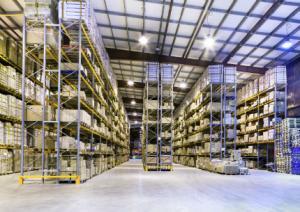
Once the x/z coordinate of the storage compartment has been reached, the vehicle disengages from the racking conveyor and enters the racking compartment. It is equipped with a lifting device and can load and unload the loading units independently. The cross beams of the rack storage system have two horizontal surfaces: The upper surface is the support surface for the loading unit, and the lower surface is used as the running surface for the satellite vehicle.
Advantages and disadvantages of satellite storage systems
The advantages of satellite rack storage are compact, space-saving storage, automation and direct access. It thus combines the advantages of drive-in rack storage and single rack storage.
The disadvantage is that the steel construction of the shelves is very cost-intensive, as the satellite vehicle requires an excellent quality of craft.
Shelving storage
Shelf racking systems are used for the storage of non-palletized loading units. This storage type is preferably used for picking small parts. The stored goods are arranged next to each other in containers of different sizes. All stock items can be accessed directly. Fixed or movable partitions are used to divide the shelves.
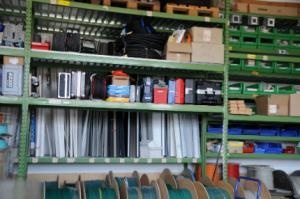
The dimensioning of the shelving depends on the following aspects:
- Quantity to be stored per storage compartment
- Turnover frequency per article
- Assortment width
- Room availability
- Dimension of bearing unit
Shelf storage systems are usually operated manually with a maximum shelf height of 2 metres. For ergonomic reasons, the compartments in the upper and lower rows of compartments should not be filled with A articles (fast-moving items), as the gripping positions are very unfavourable. For higher shelves, mobile ladders or stacker cranes are used. In order to make better use of the floor space, shelving systems are often built with several storeys. Gratings have been inserted between the floors, on which the warehouse personnel can move.
Advantages and disadvantages of shelving systems
The advantage of this storage type is its suitability for high handling capacities. Compared to many automated storage systems, it is possible to react very well to strongly fluctuating daily time-lines. In addition, the shelving rack storage system is hardly prone to failure and functionally reliable. Necessary investments are kept to a minimum.
The disadvantage of this storage type is its limited automation capability. The need for personnel is correspondingly high.
Drawer rack storage
The drawer rack warehouse is used to achieve clear and space-saving storage. Loading units are stored in drawers. The construction resembles a conventional drawer cabinet. The use often takes place in combination with a shelf rack.
Advantages and disadvantages of the drawer racking system
The advantages are, as with shelf storage, low susceptibility to faults, functional reliability and suitability for high handling rates.
Disadvantages are the high personnel requirements and, compared to the shelving system, the lower flexibility in the partitioning of the drawers.
Cantilever rack storage
The cantilever racking is suitable for the proper storage of long goods, such as bar stock and plate stacks. It is preferably used in the iron or wood processing industry. The storage rack consists of vertically arranged centre supports with vertical feet. The cantilevers are lateral outriggers on which the stored goods are placed. The length of the cantilevers and the distance between the centre supports depends on the load to be supported. The cantilevers are attached to the centre supports by means of welded, bolted or hook connections. Whether, for example, extendable telescopes or cantilevers with roll-off protection for bar material are used depends on the area of application. Storage and retrieval take place transversely to the rack and usually manually with a crane or forklift.
Advantages and disadvantages of the cantilever racking system
Advantages are possible individual access to stored goods, the compact and proper storage of certain stored goods and a good overview.
Disadvantages are that a large amount of space is required for operation and automation is only possible to a limited extent. In addition, the investment costs are very high.
Honeycomb racking warehouse
The honeycomb rack is exclusively suitable for the storage of long goods. Many designs require the use of long pallets or cassettes to fix the bar material. On the front side, the containers are pushed into shelves, which means that the front view of the shelf wall resembles a honeycomb. The long goods cassettes of storage and retrieval vehicles are stored and retrieved by special load handling devices. In order to be able to push the heavy long goods cassettes into the compartment with low friction, the shelves are often equipped with roller conveyors or similar.
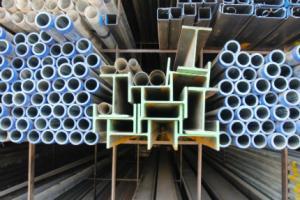
Advantages and disadvantages of honeycomb shelving systems
The advantage of the storage type is its suitability for automation. The honeycomb rack storage system is mainly used for space-saving storage of slowly rotating articles.
The disadvantage is that the handling capacity of the rack type is limited by the use of the rack conveyor.
Storage techniques – Dynamic rack storage
Storage equipment is considered to be dynamic if the loading units are moved on the rack after storage. A distinction is made between the movement of loading units on fixed shelves, the movement of loading units with moving shelves and the movement of loading units with conveyors.
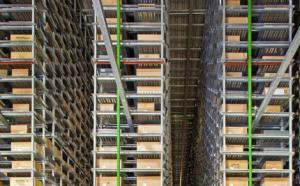
Dynamic rack storage can be divided into six basic types:
- Flow rack storage
- Compact shelving warehouse
- Mobile rack storage
- Push-in rack warehouse
- Carousel storage
- Rotary Rack
Flow rack storage
In the flow rack warehouse, a continuous movement of the stored goods from the storage side to the retrieval side takes place in a rack channel. The shelf channels are arranged in blocks. Only one article type is stored per shelf channel.
The load units are moved either by the gravitational force acting on the frame or by external influences such as a driven roller conveyor. In the case of movement by gravity, the trajectory is inclined by two to eight degrees. The inclination of the track can be readjusted at any time by means of plug-in connections. This is necessary when the loading units on the rail no longer move by themselves. For the purpose of facilitating access, the track of a container flow rack storage system is inclined so far that the foremost loading unit is at an angle of up to thirty degrees to the loading unit behind it. The channel length should not exceed twenty meters.
Pallet flow rack warehouses, on the other hand, are loaded and unloaded with the help of forklifts. Access is relatively easy by adjusting the angle of inclination of the fork according to the inclination of the shelf channel. The canal is usually up to forty meters long.
Advantages and disadvantages of flow rack storage systems
The advantages of the flow rack warehouse are its good, fixed structure, clarity and automation. It enables high handling rates.
The disadvantage is that although channels can be easily attached to rack rows, restructuring the rack channels to a changed assortment during operation is only possible to a limited extent. Depending on the conveyor equipment, the investment costs and the susceptibility to faults are relatively high.
Compact shelving warehouse
A compact rack storage system is highly dynamic and usually consists of many autonomous units. Loading units are stored on roller pallets and these are connected by couplings. Several units are joined together in this way.
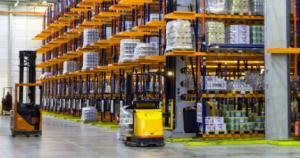
Transfer trolleys, so-called pallet trolleys, are used for storage and retrieval or coupling and uncoupling pallets. By coupling a trolley, the attached pallets are also moved when the foremost pallet is pulled. Lifting and lowering stations serve as transport vehicles on a vertical level. Buffer spaces are used to sort loading units so that they can be made available subsequently as quickly as possible.
Advantages and disadvantages of compact shelving systems
The advantage of the compact warehouse is that several trolleys and lifting/lowering stations can be used simultaneously on each level. This allows a high overall throughput to be achieved. The warehouse is also modularly expandable.
A disadvantage is the high capital expenditure required to enable automation.
Mobile rack storage
With mobile racking systems, the loading units are stored in rows. The storage racks are mounted on undercarriages, which in turn are on guide rails. This allows the shelves to be moved horizontally on the rails.
The individually driven undercarriages usually accommodate a double shelf, i.e. two rows of shelves. Double shelves are usually placed adjacent to each other. Before a specific storage compartment can be accessed, adjacent rack rows must be moved and an aisle formed. Only when the space between the lines is wide enough can the hoisting equipment enter the aisle. Depending on the particular requirements, a mobile racking system can be used, for example, for pallet or cantilever racking.
Advantages and disadvantages of a mobile racking system
A great advantage of mobile shelving is the possibility of maximum volume utilisation. In addition, the stored goods are protected against external influences within an assembled block. The flexible design of the individual aisles between the shelves is also worth mentioning.
The disadvantages are the higher investments and the time required for each rack movement until the racks have moved to the corresponding retrieval position.
Push-in rack warehouse
The push-in shelving system consists of several double shelves arranged one behind the other. Its design corresponds to that of a flow rack warehouse. However, the goods are stored and retrieved from the same side in the push-in rack warehouse.

In order to be able to remove goods from the individual compartments, rollers are attached to the underside of the shelves. This allows each shelf to be pulled out individually. If large containers or pallets are to be stored in the push-in rack, they are removed by means of floor conveyors. In this case, there are no rollers on the shelf. In the case of light-duty shelving units, the guide is provided by guide rails.
Advantages and disadvantages of push-in shelving systems
The advantage of the push-in shelving system is the similarly good space utilisation as with the mobile shelving system.
A disadvantage is the low handling performance. Because the goods are stored one after the other, only the LIFO principle (“Last in first out”) is possible for each lane without any circumstances. Additional investments are required for push-in rack warehouses with roller pedestals.
Carousel storage
Carousel storage systems are dynamic racking systems in which the storage units are moved by a rotational movement of the entire storage rack.
The picking principle “goods-to-man” applies, i.e. the picker is at a workstation and the storage rack rotates until the desired storage compartment is ready. While the operator removes goods from a shelf, the next position to be controlled can already be searched for in the adjacent shelf. Short access times can be achieved by controlling shelf circulation by means of an optimised compartment preselection.
Depending on the direction of rotation, two rack types can be distinguished:
- Carousel warehouse
- Paternoster rack storage
With the carousel storage system, the storage rack is moved horizontally. Here nacelles are suspended in driven chains. These gondolas are in turn divided into individual storage compartments.
With the paternoster rack storage system, the storage rack is moved vertically. It is mostly used for the storage of small parts.
Advantages and disadvantages of the carousel warehouse
The advantages of the carousel warehouse are short access times and high throughput rates.
A disadvantage is the impact of the high degree of mechanisation on flexibility. The adaptability to a changed assortment structure is very low. The carousel warehouse is therefore unsuitable for rush orders. For this reason, the carousel warehouse is preferred for continuous incoming orders.
Rotary Rack
A Rotary Rack is a sorting accumulator for small containers. It is highly dynamic and combines the principles of the two storage types “carousel” and “paternoster” of the carousel warehouse.
The containers are stored on several levels, one above the other. Each of these planes rotates one axis independently of the other. A vertically rotating paternoster is connected to this horizontal principle. In each storage and retrieval cycle, there are movements of the paternoster and at least one plane.
Advantages and disadvantages Rotary Rack
The advantages of the Rotary Rack are high retrieval throughputs, as the order positions are evenly distributed over all levels and can be controlled in parallel.
The disadvantage is that the maintenance effort is relatively high due to the high degree of automation.
Storage techniques – Storage on conveyors
In conveyor technology, the term “conveying equipment” refers to equipment and aids used. Auxiliary materials can be, for example, cartons, crates, pallets and lattice boxes. The storage of goods directly on the conveyor system is used when the functions ‘convey’ and ‘store’ are to be combined. The integration of these basic logistical functions is aimed at, for example, in parcel sorting systems. Classic warehouses use continuous conveyors and discontinuous conveyors mainly for transporting goods.
For storage on conveyors, there is the possibility of storage on continuous conveyors and storage on discontinuous conveyors.
Storage on continuous conveyors includes, for example:
- Roller conveyor
- Belt conveyors
- Circulating conveyor (e.g. paternoster)
- Chain conveyors
Storage on discontinuous conveyors, for example, includes:
- Motor vehicles (e.g. forklifts)
- Electric monorail conveyor
- Automatic vehicles
- Storage and retrieval machines
Storage of hanging goods
Hanging goods are goods that may only be transported or stored hanging, such as textiles or certain foodstuffs. These special goods may only be stored in such a way as to avoid damage or loss of quality.
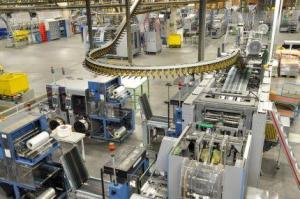
The simplest solution: The warehouse does not consist of storage spaces for pallets and packages, but offers static suspended shelves. If only storage space is available in the warehouse, the goods are hung in trolleys. Trolleys are defined as loading units, similar to a pallet. They usually consist of a high trolley on rollers in which the goods can be suspended by means of one or more rods. A trolley has a certain loading capacity and can then be stored according to the usual methods. Each trolley should contain one type of goods (for example, the same article in the same size) so that you do not have to search for different goods within the actual storage unit. This saves time, is less prone to errors and provides a better overview of the storage capacities still available. The trolleys are then booked into a fixed storage location.
Automated storage of hanging goods
The methods of properly storing hanging garments described above usually refer to companies whose warehouses are not exclusively geared to hanging garments or who did not want to make major alterations to their previous storage facilities. If a warehouse is specially designed for hanging goods, an automated high-bay warehouse is often used. The goods hang on mobile storage rods, which can then be fully automatically coordinated to the respective storage locations or transfer stations. A pure high-bay warehouse for hanging goods has significantly lower investment and personnel costs than a classic high-bay warehouse with storage locations.
Special case channel rack warehouse
A channel rack storage system consists of several flow paths or push-in channels, which are arranged next to each other and one above the other in a similar way to honeycombs.
Depending on the nature of the stored goods and the frequency of use, different storage techniques are suitable. A distinction is made between the movement of loading units with conveyors, the movement of loading units on fixed shelves and the movement of loading units with moving shelves. The loading units of the channel rack storage can be moved in the channel. In push-in channels, the loading units are stored and retrieved from one side. With flow channels, on the other hand, the units are stored and retrieved from opposite directions.
An active flow rack warehouse with roller conveyors or also a compact rack warehouse are examples of a channel rack warehouse. If storage is planned for a longer period, channel rack warehouses are generally less suitable. One possibility, however, would be a compact warehouse with satellite vehicles. If the warehouse is intended more as a short-term buffer and for transport provision and there are also high article stocks, then the use of a flow rack warehouse is suitable, for example.
Advantages and disadvantages of channel rack warehouses
The advantages of the canal rack warehouse are as follows:
- High use of space
- Good degree of automation
The disadvantage is that some loading units are difficult to access if they are arranged in closely spaced channels. This poor accessibility can, in turn, lead to long access times. In addition, the use of the channel capacities is restricted by the limited filling level for single article channel occupancy. On average, the channels are filled to less than 100%.
Further reading recommendations:
Warehouse management - as simple as possible, as complex as necessary
Our WMS offers you an individually tailored, lean and process-oriented warehouse management.

Also available in Deutsch (German)